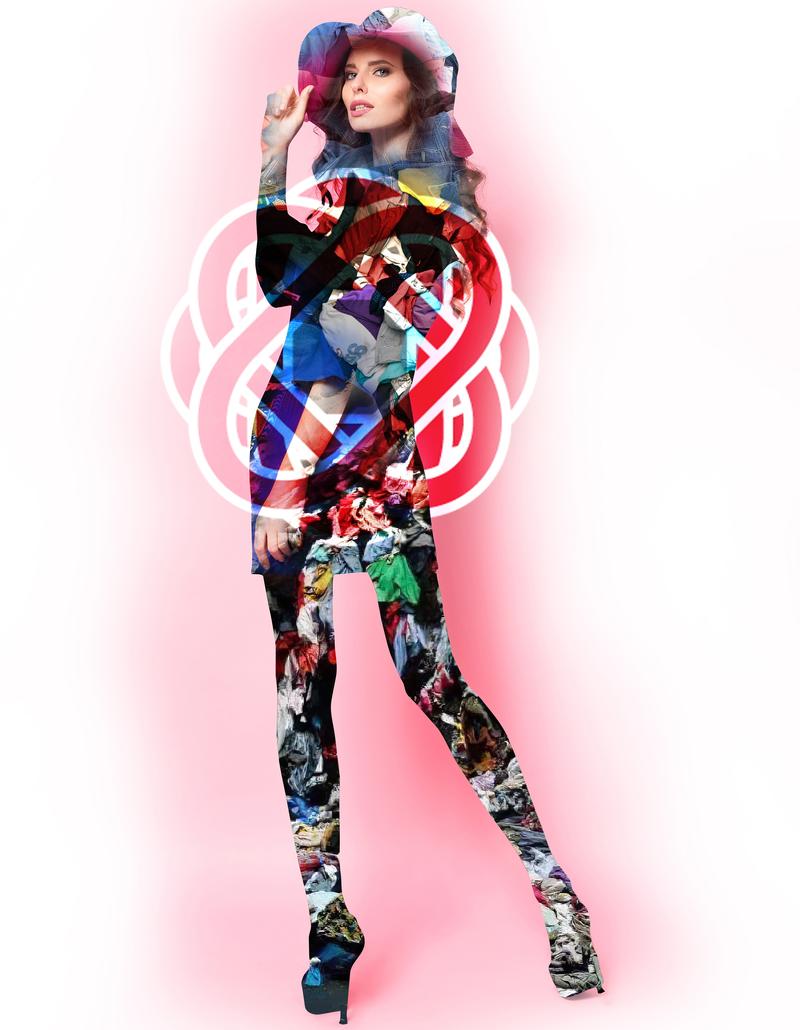On the road to circular fashion

Making fashion sustainable and circular is no mean feat, but discerning Hong Kong consumers are becoming more aware of the damage and pollution they've done to the environment through waste. Wang Yuke reports from Hong Kong.

We demonize fashion and retail as a malicious vampire and destroyer of the environment but never realize that we, as consumers, are complicit in it. The stark fact is that we do know we're guilty, but haven't a clue about what to do to make up for it. It's a dilemma for Hong Kong.
Sometimes, we're oblivious to how polluting and disastrous the fashion business is to the planet because the repercussions are chronic, intangible and not immediately visible. The enormous volume of textile waste dumped into Hong Kong's landfills each day speaks for itself. Its weight is about 1.5 times that of the Big Buddha on Lantau Island — a bronze statue that's 34 meters tall — according to a study by Redress, a pioneering Hong Kong charity group campaigning for sustainable consumption.
Globally, the United Nations has warned that by 2050, the equivalent of three planets will be needed to provide the natural resources required to sustain current lifestyles.
Most Hong Kong people would vote for a circular fashion industry. But when asked what one could do to promote circularity, most couldn't or wouldn't come up with a desirable answer.
Redress has launched a "Takeback Program" along with nine world-leading fashion brands, including Zara, Pull & Bear, Rue Madame and Tommy Hilfiger, to encourage consumers to put their used or unwanted clothing in 38 collection boxes placed at different locations across Hong Kong. The clothing collected will be sent to Redress to be sorted and redistributed to various destinations, depending on their condition and target users. Luxury garments that are still in good shape and account for up to 10 percent of the items collected will end up at Redress' secondhand shops. About 75 to 80 percent of the clothes collected would be handed to charity groups, such as Crossroads, the Refugee Union, the Young Women's Christian Association, Po Leung Kuk, and PathFinders Hong Kong. Clothing that is badly damaged, dirty or moldy will be recycled or downcycled.
Sorting out the items gathered is a demanding and laborious task and is done by hand. Care is taken not only to ensure that every single item can be reused, but also that it lands at the right place. For example, only items considered suitable for children will go to PathFinders, which is dedicated to supporting children with migrant mothers. Pet charity groups that Redress has teamed up with can deal with discarded blankets and throws.
According to Christina Dean, who founded Redress, very few items are resold as they have to be in sound condition, which is only a fraction of those collected. "Besides, there are not enough charity shops and resale stores in Hong Kong," she added.
Redress sometimes can secure a roomful of secondhand things, which is heartening, as it shows that people are committed to reducing textile waste and prolonging the life of used items. But some donors are consciously doing it for the sake of the environment, while others are merely throwing away unwanted stuff to make more space in their wardrobes. It's hard to pinpoint the motivation of donors, but the kernel of truth is that "the first group (of people) is definitely expanding because we know that, globally and in Hong Kong, people are inarguably becoming more concerned about the environment and more aware of their role in morphing the polluting fashion business into a more-sustainable one", Dean said.
She's cognizant of a paradigm shift in how people in Hong Kong and worldwide interpret fast fashion as wasteful and destructive in the past 14 years since Redress was set up. Fifteen years ago, people were just morally prodded into agreeing that fast fashion is polluting the environment, but might not consciously feel it, Dean recalled. But today, there's an onslaught of reports of water pollution, carbon emissions, diminished biodiversity, land erosion and microplastics, she said. All these heinous effects are brought about by fashion. There are appalling statistics on how people's squandering behavior has left the ecosystem out of whack. "So you would have to be living under a rock not to know that fashion has a negative impact on the environment," Dean said.
Sustainability practices
However, in recent years, fashion businesses have been seriously engaged in strategic sustainability practices, as opposed to merely taking it as a box-ticking exercise.
VF Corp — one of the world's largest apparel, footwear and accessories companies — is leading the circular fashion dynamic. In 2018, North Face — a brand under VF — started VF's first e-commerce platform. In the first year alone, the program had saved more than 16.8 metric tons of apparel from going to landfills, allowing them to be reused by the consumer. Last year, Timberland launched a rebottling campaign, tapping into an innovative method to transform discarded plastic bottles into recycled polyester yarn to be reused in footwear production. By September, the equivalent of 380 million plastic bottles had been incorporated into Timberland's footwear products.
Despite the positive shift, Dean regrets that 170 metric tons of clothes are heading for the landfills daily in Hong Kong. This signals that the message of steering used clothing clear of landfills hasn't gone down with some. It can take 200 years for textiles to decompose in a landfill, during which time, toxic chemicals and dyes, methane and other greenhouse gases — all major contributors to climate change — are generated.
But there is nothing wrong with being fed up with used clothes, shopping for new ones to refresh one's image and wardrobe, or being on a buying spree as a pastime to kill boredom and unwind, Dean said. It's just a desire embedded in every human being's psychology that should be respected. "Let's not fight it! But they can definitely do it in a more sustainable way."
Fast fashion cannot be obliterated as it has buttressed the global economy and lends a thrill to people's lives. "What we need to do is buy less, buy better and wear it longer." The hacks for wearing it more without getting bored is to "style your clothes and be more individual with that clothing", which is the rule of thumb Dean offers. "Varying accessories to go with the same outfit. Tweaking with the way the same outfit is worn. What we need to learn is to wear our current clothes differently and creatively," Dean said.
Toying with the same clothing and reinventing styles is not only sustainable and economical, but also liberating and fun. "It's also much more meaningful. I genuinely think that people who look both cool and fashionable are those who have actually put time into their wardrobes. It (their style) has a greater reflection of who they are because they might have saved the money (from buying new ones) and gone to a tailor to get that lovely dress fitted perfectly and personally stylized," Dean said.
A sustainable but equally fulfilling alternative to a shopping frenzy is engaging in a personally enjoyable experience, she suggested. "Enroll in a course to learn a new skill, visit a museum or have a lovely dinner with your loved ones." According to an article in the journal Psychological Science, published in 2014, we tend to hold dear to a joyous experience more than a piece of garment — a theory that has been borne out by scientific studies. The reason why experiential purchases bring more enduring happiness than material purchases is because the eager anticipation of an experience feeds into the overall happiness.
Part of the onus to sway consumers into making sustainability-informed wardrobe choices is on fashion designers. How well sustainable solutions are incorporated in the design has a direct influence on consumers with regard to how effectively they re-examine their sumptuous lifestyles. Jessica Chang, who won the Redress Design Award 2021, feels obliged to do her bit by experimenting with environmentally friendly techniques, including zero-waste-patterning, dead-stock fabrics and upcycling. In normal patterning practice, fabrics with inconsistent seams and hems cannot be harmoniously pieced together, which involves a lot of cutting and discarding. Roughly 15 percent of the fabric used in the fashion industry is wasted. By a creative zero-waste design pattern, pieces can be fit together seamlessly without leftover scraps. Big factories normally order more than enough fabrics, resulting in abundant leftovers. They would sit idle in the warehouses. Hence, the name "dead stocks". Chang said she will source and utilize those dead stocks in her designs. She will also upgrade or upcycle second-hand clothing to create new iterations in her designs. For example, in her acclaimed design, she used two worn sweaters from friends and chiffon fabric from a photo shoot studio to make a combination of a jumpsuit and trench coat, boasting coziness and flaunting smart causal stylishness.
Technology's power
Chang makes the point of striking a balance between a chic silhouette and practicality. "If the design is not wearable (in real life settings), it's unsustainable. So I would always focus on designs that are accessible to everyone."
The effect of technology in disrupting the noncircular fashion industry can't be overlooked. "Thanks to technology, all polyesters now can be made of recycled water bottles," Chang said. "So we have no excuse to make new polyesters." Polyester as a common ingredient in the fashion industry has been found detrimental to the environment. It releases toxic chemicals into water and the air, and it takes hundreds of years to biodegrade. "How the clothing is constructed also matters," Chang added. For example, if the seam is easily ripped apart, it's more likely to be thrown away. "So durable fabrics are always sought after as it makes clothing last longer."
The industry has also started going back to the ultimate supplier of bounties — Mother Nature — for answers to the circularity enigma. Weaving coffee ground into fabrics eliminates odor, sparing clothing repeated washes and, therefore, tear and wear; making leather out of pineapple leave fiber is sustainable and humane; eco-friendly spray confers clothing water-repellent properties; and blending ground oyster shells into fabrics lends clothing ultraviolet protection properties. These examples are just the tip of the iceberg, showing that technology empowers and supports the industry in its bid to go zero-waste and circular.
Chang is disappointed that while consumers and the industry have latched on the insidious nature of fashion, there's latency in action. "I've always been struggling to accept the fact that the sustainability movement started too late."
While we constantly rave about circular fashion, we've hardly ever materialized a "full circle", she said, citing "discarded clothing being repurposed as cushion stuffing". But she's upbeat that the principle of sustainability will permeate every decision people make in their lives, thanks to the "increasing exposure" (to eco-friendly commodities).
Sustainability education in schools could be the best exposure for young cohorts with the envisioned circular future that they're expected to sculpt. Before sustainability studies become an independent discipline at Hong Kong's universities, "we must make sure that professional associations across all industries grant graduates of sustainability recognition," said Chris Lo, associate professor of fashion retail and marketing at the Hong Kong Polytechnic University.
Lo, who teaches sustainability in fashion and textiles, a core course at the Institute of Textiles and Clothing, expressed concern that most of his students feel hard-pressed to carry with them a sustainability certificate in their careers because not every company dedicates resources to corporate sustainability management.
Making fashion sustainable and circular seems to be no mean feat, as it would take multiple stakeholders — from fashion designers, brands and educators to scientists, technology developers and fundamentally consumers — to forge together toward the holy grail.
The first step toward a change is awareness. Since awareness is here, there's reason to anticipate the change.
- China accelerates nuclear fusion engineering, targeting power generation demonstration by 2030
- Xinjiang leads China in cross-border rail traffic, central Asian connectivity in 2025
- Astronauts say training helped ensure safe return
- FAST reveals insights into cosmic signals
- Year's first private rocket mission takes off
- Taiwan separatists warned of action



































